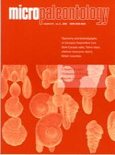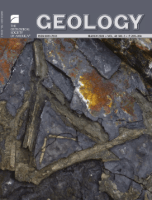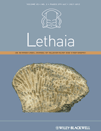
JOURNAL OF THE PALAEONTOLOGICAL SOCIETY OF INDIA
Scope & Guideline
Exploring Evolutionary Insights from the Indian Subcontinent
Introduction
Aims and Scopes
- Paleobiology and Fossil Studies:
The journal emphasizes research on fossils, including their morphology, taxonomy, and distribution, enhancing our understanding of ancient life forms. - Stratigraphy and Sedimentology:
A significant focus is placed on stratigraphic studies, including the classification and correlation of sedimentary layers, which aids in reconstructing geological histories. - Palaeoecology and Palaeoclimate:
Research often involves examining ancient ecosystems and climate conditions, providing insights into how past climates influenced biological evolution. - Microfossil Analysis:
The journal includes studies on microfossils such as foraminifera and diatoms, which are critical for understanding ecological changes and biostratigraphy. - Biogeographical Studies:
Research on the distribution of fossil taxa and their implications for understanding historical biogeography in relation to geological events. - Interdisciplinary Approaches:
The journal encourages interdisciplinary research that combines paleontology with geochemistry, climatology, and environmental science.
Trending and Emerging
- Environmental and Climatic Impacts on Fossil Records:
There is an increasing focus on how ancient environmental changes and climate dynamics have influenced biological evolution, as evidenced by studies linking fossil records to climatic events. - Multi-Proxy Analyses:
Research employing multi-proxy approaches to reconstruct past environments and ecological conditions is becoming more prevalent, showcasing a trend towards comprehensive analyses. - Freshwater and Marine Ecosystems:
An emerging interest in the paleobiology of both freshwater and marine ecosystems is evident, with studies addressing the unique evolutionary pathways and ecological dynamics of these environments. - Microfossil Diversity and Applications:
There is a notable rise in studies focusing on microfossils and their applications in biostratigraphy and paleoenvironmental reconstructions, reflecting advancements in analytical techniques. - Palaeobiogeography:
Research exploring the historical distribution and migration patterns of species in relation to geological events is gaining traction, emphasizing the importance of biogeographical studies in understanding past biodiversity.
Declining or Waning
- Obituaries and Memorials:
The frequency of obituaries and memorials has decreased, indicating a potential reduction in the number of prominent figures in the field or a shift towards focusing on active research contributions. - General Hydro-Geomorphic Studies:
Research that broadly encompasses hydro-geomorphology without specific paleontological implications has seen less attention, possibly due to a preference for more focused studies. - Taxonomic Revisitation of Historical Fossils:
While taxonomic revisions remain important, the emphasis on revisiting older taxa has diminished, as researchers may be more inclined to explore novel findings or methodologies.
Similar Journals

PALEOBIOLOGY
Connecting the Dots of Evolution Through TimePALEOBIOLOGY, published by Cambridge University Press, is a premier, peer-reviewed journal that stands at the forefront of research in paleontological sciences. With a robust commitment to advancing the study of the interactions between ancient life forms and their environments, the journal has established itself as a vital resource for researchers, professionals, and students in the fields of paleontology, ecology, and evolutionary biology. Spanning from 1975 to 2024, it boasts an impressive Q1 ranking in several categories, including Agricultural and Biological Sciences, Ecology, and Paleontology, indicative of its high impact and relevance in shaping contemporary scientific discourse. While the journal is not open access, it offers a variety of subscription and access options, ensuring broad distribution and visibility of published research. As a leader in its discipline, PALEOBIOLOGY aims to facilitate a deeper understanding of our planet's biological history, making it an essential publication for anyone interested in the dynamics of life across geological time.

REVISTA BRASILEIRA DE PALEONTOLOGIA
Advancing Knowledge of Biodiversity and Extinction EventsREVISTA BRASILEIRA DE PALEONTOLOGIA (ISSN: 1519-7530, E-ISSN: 2236-1715) is a premier academic journal dedicated to the field of paleontology, published by the esteemed SOCIEDADE BRASILEIRA DE PALEONTOLOGIA. Operating under a Q3 quartile ranking in the 2023 Scopus statistics for Paleontology, this journal serves as a vital platform for researchers, professionals, and students to disseminate and engage with cutting-edge discoveries and methodologies in paleontological studies. With a broad scope that encompasses various aspects of Earth's historical life, REVISTA BRASILEIRA DE PALEONTOLOGIA provides an essential resource for the scientific community, particularly those based in Brazil and South America. The journal is committed to promoting rigorous research and fostering collaboration among scholars, ultimately contributing to advancements in the understanding of past biodiversity and extinction events. Its thoughtful curation of articles since 2010 ensures that it remains at the forefront of paleontological scholarship, despite its limited HIndex and open access options. This journal is a crucial asset for anyone looking to deepen their understanding of evolutionary processes that have shaped our planet.

BULLETIN OF THE GEOLOGICAL SOCIETY OF DENMARK
Exploring Earth's History Through Danish PerspectivesBULLETIN OF THE GEOLOGICAL SOCIETY OF DENMARK, published by the Geological Society of Denmark, serves as a key platform for the dissemination of original research and comprehensive reviews related to geological studies in Denmark and beyond. With an ISSN of 2245-7070, this journal provides a significant avenue for sharing findings that contribute to our understanding of geological processes, resources, and the history of the Earth. Although it operates under traditional access options, the journal encourages a rich scholarly dialogue among researchers, professionals, and students alike. Its impact is evident in the broad scope it covers, catering to diverse areas of geology, including but not limited to sedimentology, paleontology, and environmental geology. By fostering an environment of knowledge sharing, the BULLETIN OF THE GEOLOGICAL SOCIETY OF DENMARK is not just a journal; it is a vital resource for anyone invested in advancing geological science.

MICROPALEONTOLOGY
Exploring the Depths of Microfossil ResearchMICROPALEONTOLOGY is a prominent journal dedicated to advancing the field of paleontology, published by MICRO PRESS. With an ISSN of 0026-2803 and an E-ISSN of 1937-2795, this esteemed publication has been a vital resource since its inception in 1979, continuing to influence the field through 2024. The journal ranks within the Q2 category for Paleontology, highlighting its relevance and quality in the academic community. Notably, it holds a Scopus rank of #41 out of 113 within the Earth and Planetary Sciences field, placing it in the 64th percentile, indicative of its significant impact. Although not an open-access journal, MICROPALEONTOLOGY remains committed to disseminating crucial research findings, making it an essential platform for researchers, professionals, and students dedicated to exploring the intricacies of microfossils and their implications for understanding past environments. With its strategic focus and rigorous peer-review process, this journal plays a critical role in bridging past geological events with contemporary scientific inquiries.

GEOLOGY
Elevating the Discourse in Earth and Planetary SciencesGEOLOGY, published by the Geological Society of America, Inc, is a premier journal dedicated to advancing knowledge, research, and discussion in the field of geology. With an ISSN of 0091-7613 and an E-ISSN of 1943-2682, this journal stands out with an impressive Q1 ranking in Geology for 2023, positioning it among the top journals in the realm of Earth and Planetary Sciences, specifically holding a remarkable rank of 11 out of 321, reflecting its 96th percentile status. This journal aims to publish innovative research articles that cover all aspects of geology, from tectonics and sedimentology to paleontology and mineralogy, offering invaluable insights for researchers, professionals, and students alike. Although not currently open access, GEOLOGY maintains a rigorous review process ensuring the quality and integrity of the research it publishes. For more than five decades, spanning from its inception in 1973 to the upcoming publications in 2024, GEOLOGY has been instrumental in shaping the geological discourse and continues to be a vital resource for the scientific community.

LETHAIA
Shaping the Future of Earth's Biological NarrativesLETHAIA, an esteemed journal published by Scandinavian University Press - Universitetsforlaget AS, serves as a vital platform for the dissemination of innovative research in the fields of paleontology as well as ecology, evolution, behavior, and systematics. Established in 1968 and continuing its impactful journey until 2024, LETHAIA has consistently contributed to advancing scientific understanding of Earth's biological and geological history. With a 2023 impact factor placing it in the Q2 category for both Paleontology and Ecology, Evolution, Behavior and Systematics, the journal is recognized for its high-quality, peer-reviewed articles that engage and challenge the academic community. Researchers, professionals, and students alike will find LETHAIA to be an indispensable resource for the latest findings, methodologies, and theoretical advancements in these interlinked disciplines.

Palaeontographica Abteilung B-Palaeophytologie Palaeobotany-Palaeophytology
Exploring the Depths of Plant EvolutionPalaeontographica Abteilung B-Palaeophytologie Palaeobotany-Palaeophytology is a distinguished journal published by E SCHWEIZERBARTSCHE VERLAGSBUCHHANDLUNG in Germany, focusing on the intricate study of paleobotany, including the evolution and diversity of plant life throughout geological time. With an impressive Scopus ranking of #25 out of 113 in the field of paleontology, the journal is recognized for its contribution to advancing our understanding of ancient ecosystems, earning a prestigious Q2 quartile ranking in 2023. Despite its lack of open access options, the journal provides invaluable insights for researchers, professionals, and students alike who are passionate about exploring the fossil record and its implications for plant evolutionary history. The journal's collaborative nature and periodic publication schedule, ranging from 2005 to 2024, ensure that it remains at the forefront of paleontological research.

Swiss Journal of Palaeontology
Connecting Past and Present Through FossilsSwiss Journal of Palaeontology, published by SPRINGER INT PUBL AG, stands as a leading platform for innovative research within the field of paleontology, contributing significantly to the understanding of Earth's historical life forms and their evolutionary pathways. With its ISSN 1664-2376 and E-ISSN 1664-2384, this journal has established a strong presence in academic circles, recognized as a Q1 journal in the category of Paleontology for 2023. Moreover, it ranks 20th out of 113 in the Earth and Planetary Sciences, securing an impressive 82nd percentile on Scopus, underscoring its influence and reach in the scientific community. The journal publishes cutting-edge research findings, theoretical advancements, and comprehensive reviews that span the globe, making it an essential resource for researchers, professionals, and students in the paleontological sciences. For those interested in contributing to and learning from the latest discoveries, the Swiss Journal of Palaeontology promises to be an invaluable addition to your academic library.

Stratigraphy
Uncovering the Past, One Stratum at a TimeStratigraphy is a distinguished journal dedicated to advancing the field of paleontology and stratigraphic research. Published by MICRO PRESS in the United States, this journal is accessible via its ISSN 1547-139X and E-ISSN 2331-656X, providing an essential platform for researchers, professionals, and students alike. With a robust focus on the intricate relationships between geological time and the fossil record, Stratigraphy aims to disseminate high-quality research that enhances our understanding of Earth’s history. Its ranking within the 2023 Q2 category of paleontology reflects its commitment to scholarly excellence, as noted by a Scopus ranking of #65 out of 113 in the Earth and Planetary Sciences domain, placing it in the 42nd percentile. Although not open access, the journal's valuable contributions from 1988 to 2024 encourage a collaborative dialogue among the scientific community, underscoring the significance of stratigraphic studies in environmental and evolutionary research.

PALEONTOLOGICAL JOURNAL
Unlocking the Mysteries of Our Planet’s History.The PALEONTOLOGICAL JOURNAL, published by PLEIADES PUBLISHING INC, is a premier platform for the dissemination of research in the field of paleontology. With an ISSN of 0031-0301 and E-ISSN 1555-6174, this journal serves the academic community by providing insights into fossil studies, evolutionary biology, and the historical narrative of life on Earth. Despite being categorized in the Q3 quartile for 2023 and currently holding a Scopus rank of #84 out of 113 in the Earth and Planetary Sciences- Paleontology category, it remains a valuable resource for researchers and practitioners. The journal's coverage spans from 1990 to 2024, offering a comprehensive historical perspective while also addressing contemporary issues in paleological research. Scholars and students alike benefit from its rigorous peer-reviewed articles and the opportunity to access vital knowledge in the ever-evolving field of paleontology.